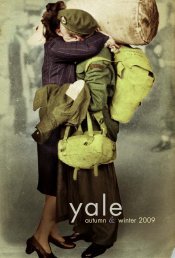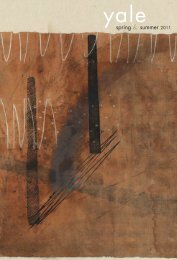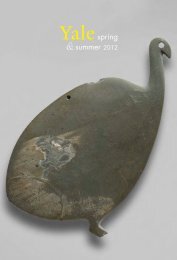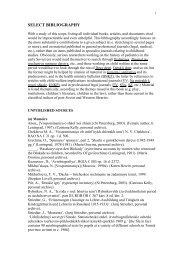View & Download - Yale University Press
View & Download - Yale University Press
View & Download - Yale University Press
You also want an ePaper? Increase the reach of your titles
YUMPU automatically turns print PDFs into web optimized ePapers that Google loves.
52 Art<br />
September<br />
400 pp. 280x220mm.<br />
80 colour + 170 b/w illus.<br />
HB ISBN 978-0-300-17660-5 £45.00*<br />
The Miraculous Image<br />
in Renaissance Florence<br />
Megan Holmes<br />
In Renaissance Florence, certain paintings and sculptures of the Virgin<br />
Mary and Christ were believed to have extraordinary efficacy in<br />
activating potent sacred intercession. Cults sprung up around these<br />
‘miraculous images’ in the city and surrounding countryside beginning<br />
in the late 13th century. In The Miraculous Image in Renaissance<br />
Florence, Megan Holmes questions what distinguished these paintings<br />
and sculptures from other similar sacred images, looking closely at their<br />
material and formal properties, the process of enshrinement, and the<br />
foundation legends and miracles associated with specific images.<br />
Whereas some of the images presented in this fascinating book are well<br />
known, such as Bernardo Daddi’s Madonna of Orsanmichele, many<br />
others have been little studied until now. Holmes’s efforts centre on the<br />
recovery and contextualisation of these revered images, reintegrating<br />
them and their related cults into an art-historical account of the period.<br />
By challenging prevailing views and offering a reassessment of the<br />
Renaissance, this generously illustrated and comprehensive survey makes<br />
a significant contribution to the field.<br />
Megan Holmes is professor of the history of art at the <strong>University</strong> of<br />
Michigan.<br />
Religious Poverty, Visual Riches<br />
Art in the Dominican Churches of Central Italy<br />
in the Thirteenth and Fourteenth Centuries<br />
Joanna Cannon<br />
The Dominican friars of late-medieval Italy were vowed to a life of<br />
religious poverty. Yet their churches contained many visual riches, as this<br />
groundbreaking study reveals. Works by supreme practitioners –<br />
Cimabue, Duccio, Giotto and Simone Martini – are here set in a wider<br />
Dominican context. The contents of major foundations – Siena, Pisa,<br />
Perugia and Santa Maria Novella in Florence – are studied alongside less<br />
well-known centres. For the first time these frescoes and panel paintings<br />
are brought together with illuminated choir books, carved crucifixes,<br />
goldsmith’s work, tombs and stained glass. At the heart of the book is<br />
the Dominicans’ evolving relationship with the laity, expressed at first by<br />
the partitioning of their churches, and subsequently by the everincreasing<br />
sharing of space, and of the production and use of art.<br />
Joanna Cannon’s magisterial study is informed by extensive new<br />
research, using chronicles, legislation, liturgy, sermons and other sources<br />
to explore the place of art in the lives of the friars and the urban laity of<br />
Central Italy.<br />
December<br />
368 pp. 280x230mm.<br />
80 colour + 200 b/w illus.<br />
HB ISBN 978-0-300-18765-6 £45.00*<br />
Joanna Cannon is reader in the history of art at the Courtauld Institute<br />
of Art, <strong>University</strong> of London.












